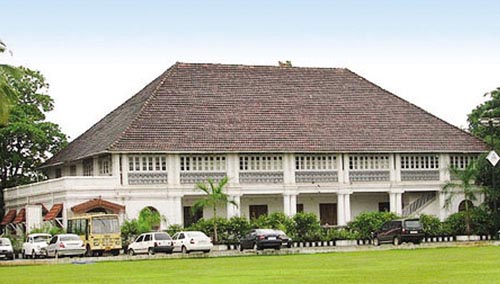Pareekshith Thampuran Museum

Information on Pareekshith Thampuran Museum (Ernakulam, Kerala) - History & Architecture
Pareekshith Thampuran Museum is the largest archeological museum in the Cochin City. It has vast collection of the Kochi royal antiquities and other collection of 19th century found in the Indian Sub continent. It is located in the DH Road, Cochin City, Ernakulum District, Kerala State of south India.
Pareekshith Thampuran Museum Architecture
Pareekshith Thampuran Museum is a typical Kerala architectural edifice built in the 18th century by the Kochi Royals. This was the royal guest house in those days. It is build with woods, granite stone, laterite stone, tiles, rock dusts, lime stones and tartars. This Durbar House is occupied in the centre of vast garden ground. Its foundations are topped by granites stones and raised up by laterite stones in the entire structures. The entire roofs are covered with terracotta tiles. This is a building with very good symmetry followed design, which looks very unique when seen from different directions with its natural scenic background. This is built in a large square structure having centrally open place, which is like a small semi square when viewed from the inner side of this house. It is a single storied building with tile roofed tops, which looks like a typical Kerala house. There are large pillars all around the edifice which stands from the ground floor to the top of the building in a parallel row along with spacious corridors in the first floor. On the inside there is a centre court yard, where the Durbar takes place. It has many large and small rooms for accommodation purpose. The first floor is supported with thick teak wood beams and slides. The entire roof top is supported with a skeletal beam of wood blocks. It has many glassed windows and semi glassed doors in this house. There are very splendid wood carving works on the doors, furniture's and all support barriers on the floors and stairs. It has a very strong steps made of teak wood to reach its first floor. There is a front welcome arched door narrowly built to reach the entrance which is also having curved arched doors with small arched ors on its adjacent sides. This is a represent the royal style of entrance for Kings in the centre and other court members on its adjacent doors. This Durbar House is in an ambient garden with water fountains.
Pareekshith Thampuran Museum History
Pareekshith Thampuran Museum was previously the Durbar house of the Kochi royal clans, which used to accommodate its royal guests, including the colonialists of that era. It was solely the Kochi royal property until it was taken by the Kerala archeological departments and converted it as museum for preserving the Kochi Royal history and antiquities. This museum was named after its last ruler of Kochi before the India's Independence named as Darsanakalanidhi Parikshith Thampuran. He was the last prince to hand over his princely state and his rule to democratic India, after its declaration of Independence. He was a great ruler of colonial times and a Sanskrit Pandit. He gave more importance to art and culture in his period. The most of his architectural works are built around the Kochi Mainland area and this Durbar House is a masterpiece of Kerala architectural work. He was locally known as Kunjunni Thamburan and Maha Raja Rama Verma. He was the immediate kin of Thamburan Oottur Raman Namboothiripad.
Pareekshith Thampuran Museum Tourism Importance
Pareekshith Thampuran Museum has vast collection of ancient coins used in Travancore. It has unique gallery for historic murals. There are many bronze and stone sculptures of distinct craftsmanship. It has many antiquities used by the Kochi Royal family as it where state inside this museum. There are also many Dravidian masterpieces of historical importance displayed by the archeological department. It is a heritage place maintained by Kerala government.
- Andaman Nicobar Monuments
- Andhra Pradesh Monuments
- Assam Monuments
- Bihar Monuments
- Chhattisgarh Monuments
- New Delhi Monuments
- Goa Monuments
- Gujarat Monuments
- Haryana Monuments
- Himachal Pradesh Monuments
- Jammu and Kashmir Monuments
- Karnataka Monuments
- Kerala Monuments
- Madhya Pradesh Monuments
- Maharashtra Monuments
- Odisha Monuments
- Punjab Monuments
- Rajasthan Monuments
- Tamil Nadu Monuments
- Telangana Monuments
- Uttar Pradesh Monuments
- West Bengal Monuments